
Workshop:
Start working with Roles
This easy-to-follow guide will help you to organize a workshop for your team. You will create and assign roles and list responsibilities.
In this workshop, your team will:
- Set a mission
- Start thinking in Roles
- Define the most crucial Roles
- Delegate Roles to team members
- Set up routines to successfully start working with Roles
After this workshop, your team is ready to start working with Roles.
Preparations
- Create a Role-up account. If someone in your organization is already using Role-up, ask them to invite you to their Role-up organization. That way, all teams in your organization can see each other.
- Add a new team in Role-up and give it a name.
- Go to the team page in Role-up and invite your team members to the team.
- Your teammates will receive an email with an invitation. Depending on mail server settings, invitations can end up in a spam folder.
- Ask team members to create their Role-up accounts before the workshop.
Team Workshop
90 - 120 minutes
-
Introduction
2 minutes+This workshop is a first step towards working with Roles as a team. Working with Roles is not complicated, just a little different. We illustrate each step in the workshop with an example.
-
Set a mission
10 - 15 minutes+Example
Oliver is looking for a summer project. He decides he wants to go to the moon. Of course, he cannot do that alone, so he invites his best friends to form a team. They call the team Moonshot. Together they declare their team mission: "Put a man on the moon."
Individually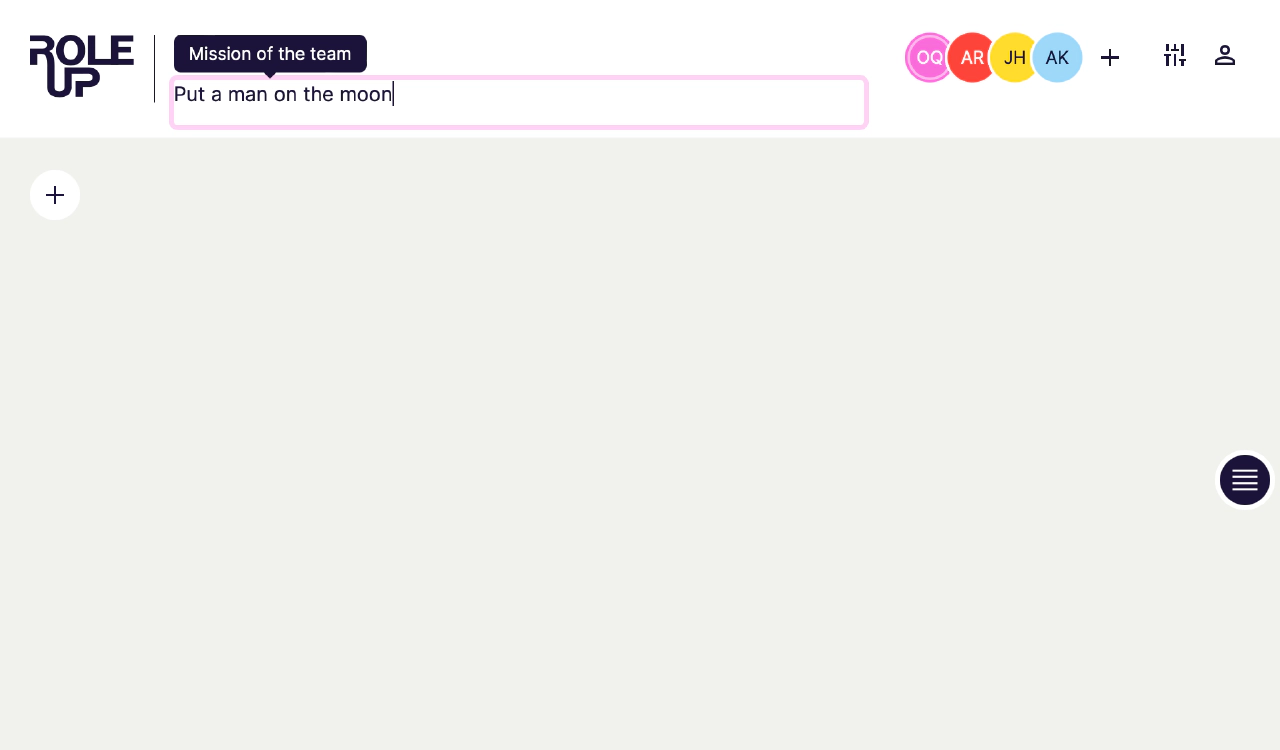
What is your team's mission?
Take 1 minute to think about the aim of the team.
- What is the reason this team exists?
- What do we want to achieve as a team?
- What is our mission?
Ask one team member to write her version of the team mission in Role-up. Other team members can suggest improvements.
Tip:
When refining your team mission, ensure that it is factually achievable by the team. Elements outside the team's influence should not be part of your mission. The team mission should be something the team can accomplish independently. As short as possible, as long as it needs to be.
-
Define the team's most crucial work
15 - 20 minutes+Example
Oliver and his team decide that if they want to put a man on the moon, there are things they need to do. They have to:
- Build a spacecraft that can fly to the moon.
- Fly their spacecraft to the moon.
- Make a lunar selfie.
They write these chunks of work down in Role-up.
Individually
What big chunks of work does your team need to do to reach its mission?
- Envision the success of the mission. What does the situation look like where the team achieved its mission?
- What has to happen to get there? What work has to be done by the team to reach this future success?
- Write down 2 or 3 essential chunks of work the team needs to do between today and successfully achieving the team mission. Use one post-it for each piece. Keep it short.
In turn: Read out loud what you wrote on your post-its. Read without explanations. The others listen without comment.
Based on what you heard, you (as a workshop facilitator) propose the three most essential chunks of work. For each one, you create a Role in Role-up (by clicking on the (+) icon beneath the team mission). Type the chunk in the field labeled 'Goal.' Leave the other input fields empty for now.
Remember that it doesn't have to be perfect. Focus on speed and consensus rather than precise wording. These three proposed chunks are a starting point. You will refine them as a team.
Congratulations! You defined the three most important things you need to do as a team. There are your first Roles. Let's give them a name.
-
Name your Roles
5 minutes+Example
Oliver and his friends add a catchy title to each chunk of work. They choose to call them: "Rocket Engineer," "Pilot," and "Moonwalker." The names make it easier to talk about the chunks of work. And who doesn't want to be a Rocket Engineer?
Together
For each Role in Role-up, ask one team member to add a title in Role-up. When the three titles are on the board, do a quick round of suggestions to improve the clarity. Keep it brief, and try not to overthink it.
-
Choose your Role
5 minutes+Example
Oliver and his friends conclude that building a rocket is a lot of work. They decide to delegate the Role of Rocket Engineer to 3 persons: Oliver, Alex, and Anna.
Jules will be the Pilot. And since this will put him inside the spacecraft, he can also fill the Role of Moonwalker.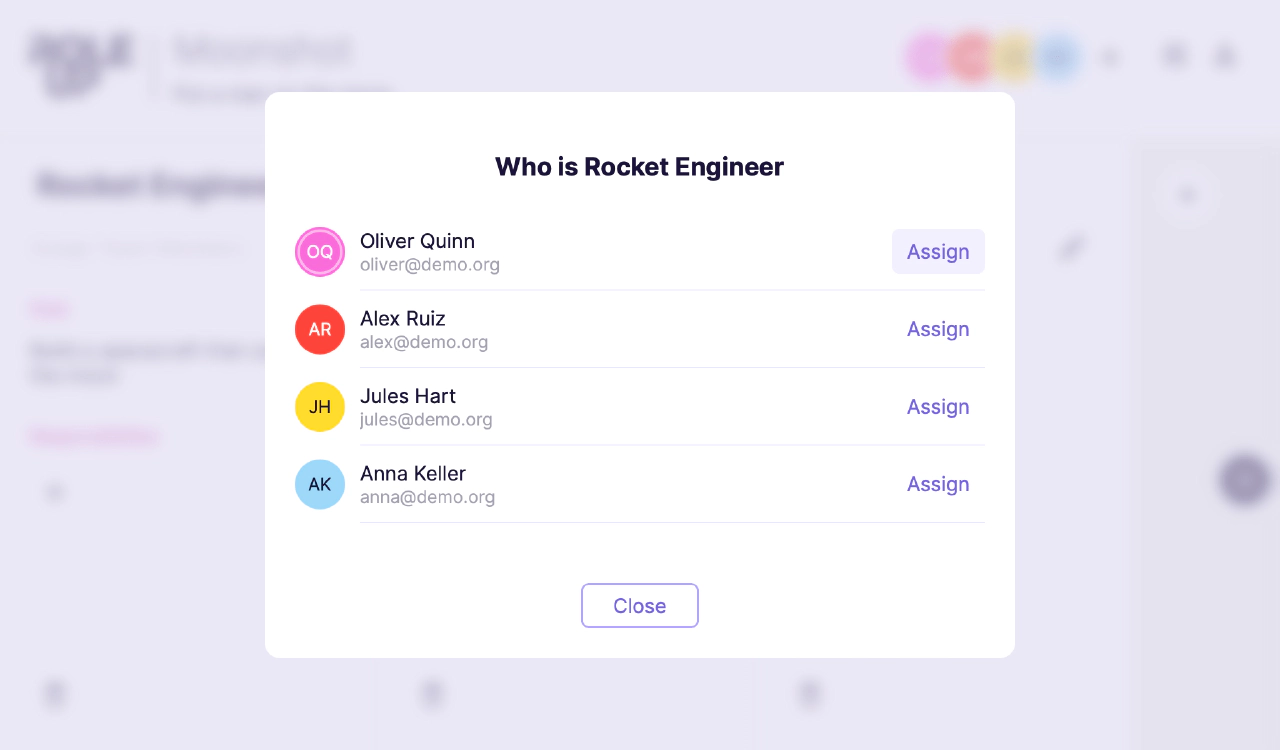
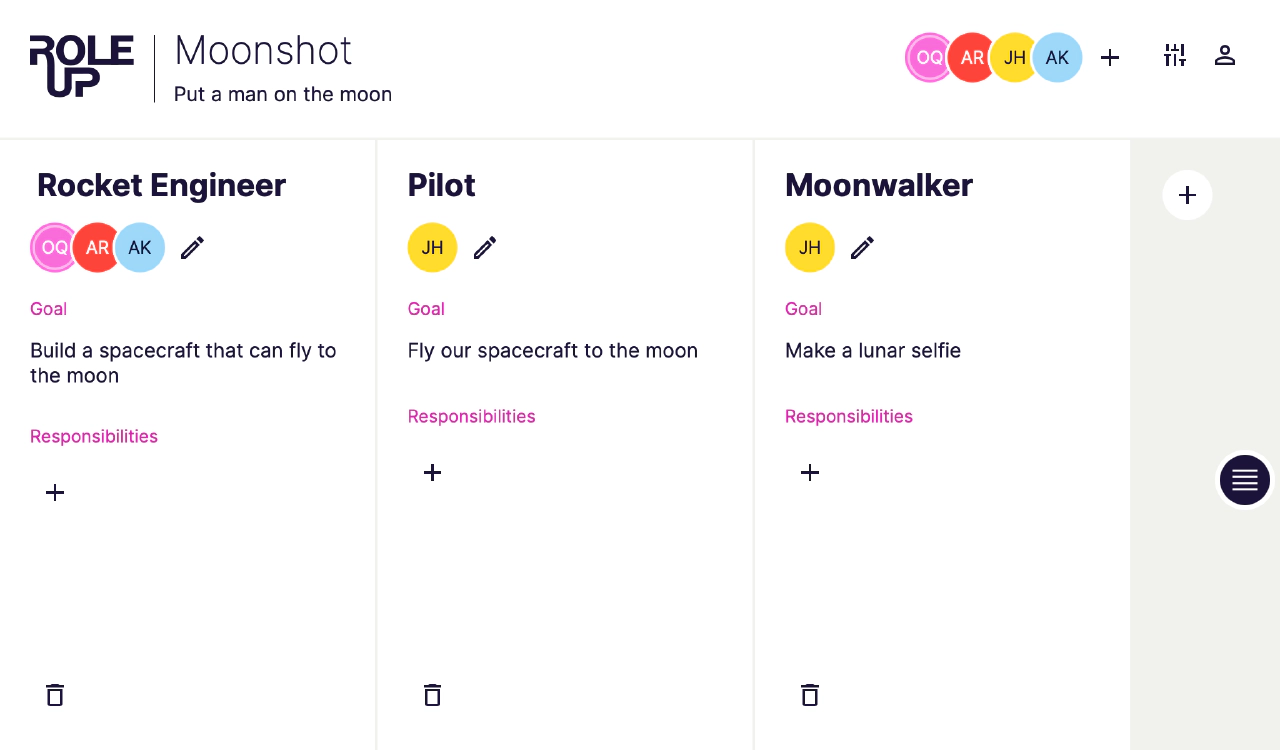
As you see, a team can delegate a Role to multiple persons. And it is possible to fill more than one Role for your team or organization.
IndividuallySo how will you contribute to your team's mission? On which of the core Roles do you work?
- Pick the Role that you will mainly work on
- Click on the pencil icon on the Role
- Assign yourself to the Role
Assign yourself to all Roles where you contribute significantly. If you do not contribute to a core Role, that's no problem. Additional Roles will be added later in the workshop.
-
List essential responsibilities per Role
15 - 20 minutes+Example
Jules will fill the Role of Pilot. That means he will be responsible for that part of the team's work. But what exactly is "that part"? They decide to write down what a Pilot's exact responsibilities are. They do this for all the Roles.
Now Jules knows precisely what the others expect from a Pilot. And he can take all decisions and actions necessary to fulfill the Role.
The list of a Role's responsibilities is dynamic. The team will add and edit responsibilities regularly. Today we focus on listing the three most important responsibilities.
Together, 5 minutes per RoleThe team members NOT filling this Role discuss what they think are the crucial responsibilities. They add their top 3 to the Role in Role-up.
TogetherMake a quick round to check if the writing is clear to everyone. Rephrase responsibilities if necessary to remove unclarity or ambiguity.
Tip:
Write your responsibilities in a format that starts with a verb that ends on -ing. Each responsibility is an activity that needs doing (hence a verb) and is continuous.
Avoid words such as "Enforcing," "Ensuring," "Approving," "Overseeing," etc. Accountabilities starting with those words usually indicate an attempt to control someone else's work. -
Add some support
5 - 10 minutes+Example
Oliver has some things he knows he needs to do outside the work of the Role of Rocket Engineer. For example, he needs to reassure his neighbors and tell them he and his friends will build a space rocket in the backyard. Hardly a task for a Rocket Engineer.
The team creates a dedicated Role for all additional work supporting their mission. For now, Oliver will fill this support Role.Together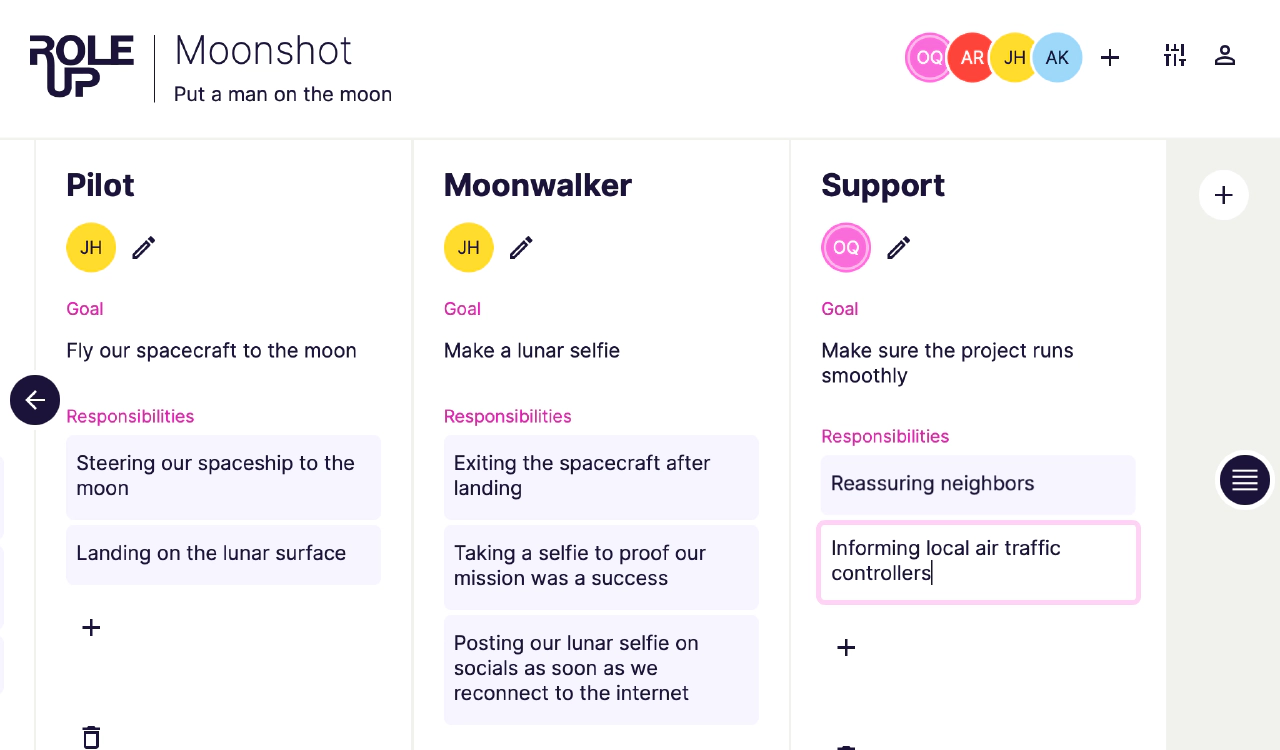
Does your team need a supporting Role? Are their team members that are not assigned to any Role yet? If so, create a new Role and assign the responsible team members. As with the other Roles, ask the members NOT filling this Role to capture the contribution to the team's mission in responsibilities. It is ok to have a wide range of responsibilities for this Role. You can split this Role into more coherent work packages in the next session.
-
Plan for success
5 minutes+Example
Oliver wants to start with the design of the thrusters. Anna and Alex can't wait to get started with some online research for webshops that sell Rocket parts. And Jules is hungry and needs a sandwich.
They know their Roles are not complete yet. And as they go, they will probably come across a few things that need doing but are not on anyone's list. So they decide to meet every Monday to discuss how they work together. Alex will see to it that everyone will be at the meetings. He will also research how to run a quick and smooth governance meeting.
They create a fifth Role for this work: the Facilitator.Together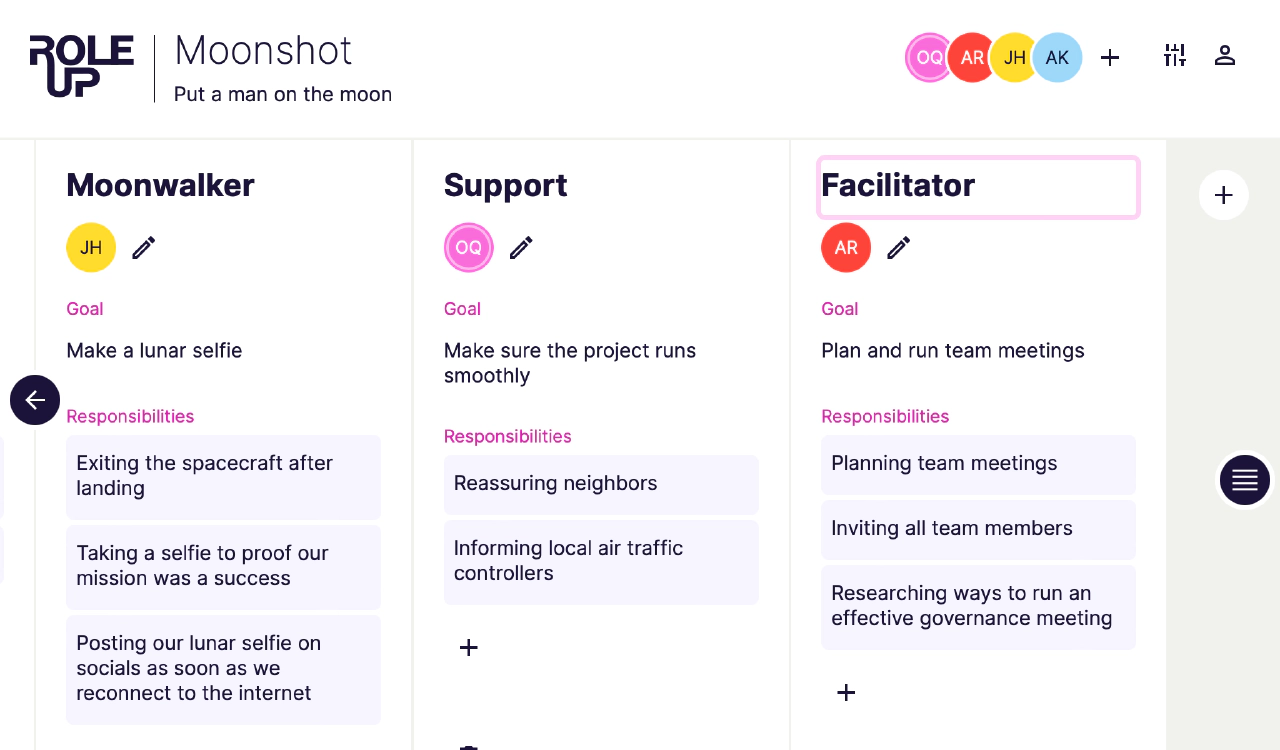
Who will be your team's Facilitator?
Create a facilitator Role, list the primary responsibilities and decide who will fill this Role.Tip:
Try to fit a recurring governance meeting in an existing pattern of retrospective or planning meetings. Embedding governance meetings in a current routine makes it easier for the team to get comfortable with Roles fast.
For teams just starting with Roles, a weekly meeting is advisable. Once your team gets more comfortable, and Roles become more stable and sharply defined, you can lower the frequency of the governance meetings.The Facilitator can find more on governance meetings and their frequency in this article: Working with Roles as a team.
A workshop template for a governance meeting can be found here: Run an effective governance meeting.

Last updated on
More Resources
-
Introduction to Working with Roles
A brief introduction to bring you up to speed in 2 minutes. What are Roles? How can you work with Roles? How are they used for self-management in Holacracy and sociocracy, and how can working with Roles benefit your team?
Learn the basics in 2 minutes -
How to run an effective
Once your team has defined its Roles and responsibilities, how do you keep them up-to-date? The answer is a recurring governance meeting! Read on to learn what a governance meeting is and how to run one effectively. Run effective governance meetings
Governance Meeting -
Working with Roles as a team
How can teams use Roles to work better together? What are the benefits of working with Roles for teams? How can working with Roles help your team to reduce friction and irritation, improve communication, have fewer meetings, and deliver more value?
Read about working with Roles as a team -
Why every Agile team
should use Role-up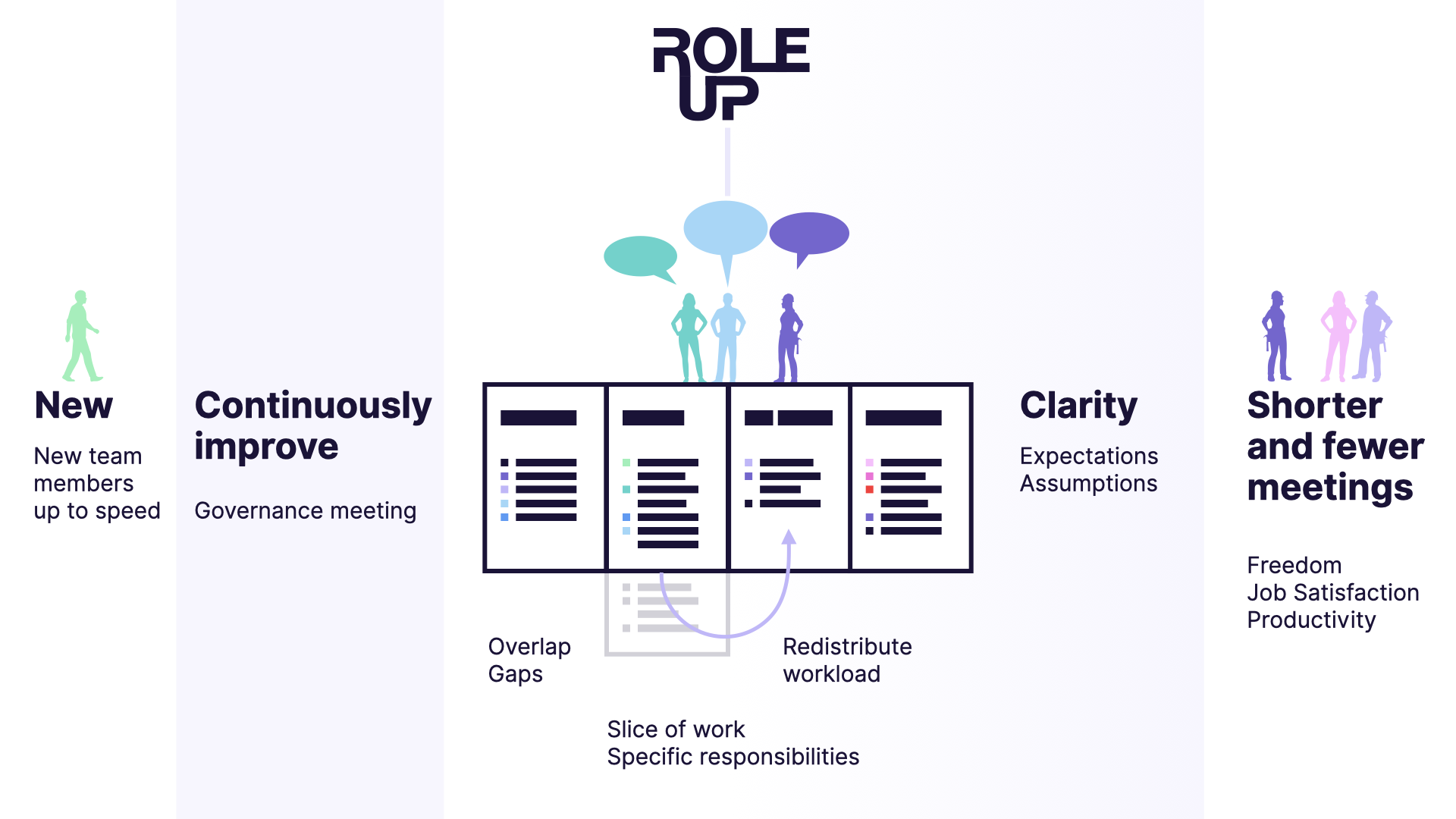
Watch our video about why every team that works agile should use Role-up and experience the advantages of working Role-based.
See why every agile team should use Role-up -
Organizations work better with Roles
How can organizations benefit from working with Roles? How can they scale and grow more agile with Roles? How does working with Roles enable companies to distribute decision-making authority and become more resilient? And why is that a good thing for a founder or CEO?
Learn how organizations benefit from Roles -
Seven reasons organizations start working with Roles
A growing number of organizations have switched to some form of self-management. This can be Holacracy, sociocracy, or other practices. What makes these companies transition to working with Roles? What frustrations and annoyances motivate this change?
Find out what we discovered -
Retrospective: Roles and Responsibilities
Does your scrum team have team members who avoid talking to each other? Is passive-aggressive behavior getting in the way of good teamwork? Are there irritations between team members? This article provides a Role-based sprint retrospective format that helps your team work better together.
Check out the exercise -
Get help from a Professional
There are professionals who can help you with setting up Roles, creating robust governance structures, and improving how you work together with your team.
View the list of professionals








